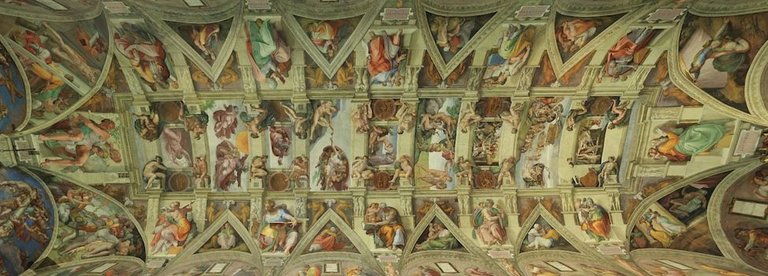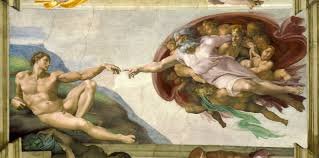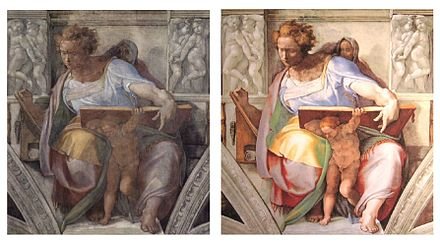The conservation-restoration of the frescoes of the Sistine Chapel was one of the most significant conservation-restorations of the 20th century.
The Sistine Chapel was built by Pope Sixtus IV within the Vatican immediately to the north of St. Peter's Basilica and completed in about 1481. Its walls were decorated by a number of Renaissance painters who were among the most highly regarded artists of late 15th century Italy, including Ghirlandaio, Perugino, and Botticelli. The Chapel was further enhanced under Pope Julius II by the painting of the ceiling by Michelangelo between 1508 and 1512 and by the painting of the Last Judgment, commissioned by Pope Clement VII and completed in 1541, again by Michelangelo. The tapestries on the lowest tier, today best known from the Raphael Cartoons (painted designs) of 1515–16, completed the ensemble.
Together the paintings make up the greatest pictorial scheme of the Renaissance. Individually, some of Michelangelo's paintings on the ceiling are among the most notable works of western art ever created. The frescoes of the Sistine Chapel and in particular the ceiling and accompanying lunettes by Michelangelo have been subject to a number of restorations, the most recent taking place between 1980 and 1994. This most recent restoration had a profound effect on art lovers and historians, as colours and details that had not been seen for centuries were revealed. It has been claimed that as a result "Every book on Michelangelo will have to be rewritten".Others, such as the art historian James Beck of ArtWatch International, have been extremely critical of the restoration, saying that the restorers have not realised the true intentions of the artist. This is the subject of continuing debate.
Previous restorations
The frescoes on the ceiling of the Sistine Chapel had a number of interventions prior to the restoration process which was started in 1980. Initial problems with the ceiling appear to have been caused by water penetrating through the floor above. In about 1547 Paolo Giovio wrote that the ceiling was being damaged by saltpetre and cracks. The effect of saltpetre is to leave a white efflorescence. Gianluigi Colalucci, Head Restorer at the Laboratory for the Restoration of Paintings for Papal Monuments, Museums and Galleries, states in his essay Michelangelo's colours rediscovered, that the early conservators treated this cosmetically by an application of linseed or walnut oil which had the effect of making the crystalline deposit more transparent.
In 1625, a restoration was carried out by Simone Lagi, the "resident gilder", who wiped the ceiling with linen cloths and cleaned it by rubbing it with bread. He occasionally resorted to wetting the bread to remove the more stubborn accretions. His report states that the frescoes "were returned to their previous beauty without receiving any harm". Colalucci states that Lagi "almost certainly" applied layers of glue-varnish to revive the colours but does not state this in his report in the interests of "preserving the secrets of their [the restorers'] craft".
Between 1710 and 1713 a further restoration was carried out by the painter Annibale Mazzuoli and his son. They used sponges dipped in Greek wine which Colalucci suggests was necessitated by the accretion of grime caused by soot and dirt trapped in the oily deposits of the previous restoration. Mazzuoli then worked over the ceiling, according to Colalucci, strengthening the contrasts by overpainting details. They also repainted some areas the colours of which were lost because of the efflorescence of salts. Areas of repainting were hatched or treated with a linear brushstroke. Colalucci states that Mazzuoli also applied a great deal of glue varnish. The restoration concentrated on the ceiling and less attention was paid to the lunettes.
The penultimate restoration was undertaken by the Restoration Laboratory of the Vatican Museum between 1935–38. The scope of the work was to consolidate some areas of the intonaco at the eastern end of the building and partially remove the soot and dirt.
Modern restoration
The Sistine Chapel before the restoration.
The preliminary experimentation for the modern restoration began in 1979. The restoration team comprised Gianluigi Colalucci, Maurizio Rossi, Piergiorgio Bonetti, and others, who took as their guidelines the Rules for restoration of works of art as established in 1978 by Carlo Pietrangeli, director of the Vatican's Laboratory for the Restoration of Pictures, which govern the procedure and methods employed in restoration. An important part of modern restoration procedure, as established by these rules, is the study and analysis of the artwork. Part of this was the recording of every stage of the restoration process. This was done by the photographer Takashi Okamura for Nippon Television Network Corporation.
Between June 1980 and October 1984 the first stage of restoration, the work upon Michelangelo's lunettes, was achieved. The focus of the work then transferred to the ceiling, which was completed in December 1989 and from there to the Last Judgment. The restoration was unveiled by Pope John Paul II on 8 April 1994. The final stage was the restoration of the wall frescoes, approved in 1994 and unveiled on 11 December 1999.

Bery interesting! Bravo!
Thank you tiko :))
Thank you for all the info on the Sistine chapel. Michelangelo was a creative genius. His work is simply amazing.
Thank you a made some research also in conbine with what i know , i like that there are people in the steem that that find interest in this thinks to , this kind of feed i expect to see , i'll come back with more interesting topics :)
Thank you , i like that there are people who appreciate the arts in the steem